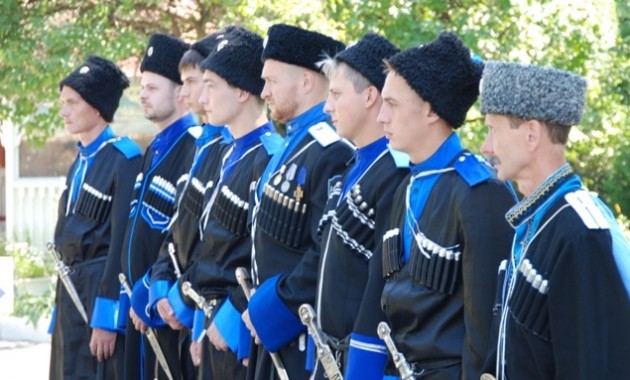
Terek Cossacks Reveal Their Extensive Participation in the Annexation of Crimea
Publication: Eurasia Daily Monitor Volume: 13 Issue: 191
By:

As President Vladimir Putin openly admitted to planning and executing the annexation of Crimea in 2014 (YouTube, March 15, 2015), the role of various Russian forces that participated in the takeover of the Ukrainian peninsula has increasingly come to the forefront. The scale of Russian involvement in the “free expression of people’s will” in Crimea is becoming ever more transparent, as the participants of the annexation clash with each other and speak out.
One such recent scandal took place among the Terek Cossacks. The Russian government has awarded nearly 150 Terek Cossacks the Medal “For the Return of Crimea” (Za Vozvrashchenie Kryma) (Regnum, May 7, 2015). Meanwhile, a Cossack leader from the city of Simferopol, Vadim Ilovchenko, accused the leader of Stavropol Cossacks, Aleksandr Pechnikov, of cowardice. Ilovchenko stated his men surrounded and forced Ukrainian soldiers to surrender as the Russian forces paved the way for the “referendum” on Crimea’s status in March 2014. By the time Pechnikov’s group arrived in Crimea from Stavropol, Ilovchenko already had 70 people under his command and wanted the Terek Cossacks to become his combatants. The latter, however, refused to become the commander’s subordinate and left Simferopol to be stationed in a rural area. One of Pechnikov’s men, Viktor Pankratov, said that his boss was scared of taking up arms and preferred to depart to safer areas on the peninsula, where there was no fighting expected. However, Pechnikov’s commander, Yevgeny Smirnov, supported his subordinate and said that the Crimean Cossacks made an impression of gamblers, who had “Barbarossa plans” (Kavkazskaya Politika, November 23).
While the small brawls between various Cossack leaders unfolded, they also spoke about the details of the Crimean operation. It transpired, for example, that over 200 Terek Cossacks were in Crimea prior to the referendum that was held on March 16, 2014. Terek Cossacks were only a part of the larger influx of Cossacks from all over Russia to the Ukrainian peninsula, and they arrived in Crimea by March 9, 2014 “to help the Crimeans.” Notably, their help involved capturing and blocking Ukrainian soldiers, and suppressing the Crimean Tatars, who spoke out against the Moscow-inspired referendum on the future of Crimea (Kavkazskaya Politika, November 23).
The new Russian authorities that captured the peninsula indicated their appreciation for the Cossacks not only by rewarding them with medals and government positions. One year after annexation, the Crimean authorities announced that the peninsula would establish its own Cossack force. The initial number of Crimean Cossacks was scheduled to be 1,000 servicemen. Reportedly, 20 Cossack organizations were applying for registration on the peninsula. After the number of Cossacks reaches 5,000, the authorities said they would register them as a Cossack Force (Kazachye Voisko) (kianews.com.ua, April 23, 2015).
Although there has been hardly any military threat by Ukraine to Crimea after the annexation, the Russian authorities still chose to create a Cossack force on the peninsula. The reason for such decision soon transpired. On December 28, 2015, an estimated 25 Crimean Cossacks under the leadership of ataman Anatoly Yakovlev, along with servicemen from the Russian FSB (Federal Security Service) and the Interior Ministry’s extremism-combatting unit, raided nine homes of Crimean Tatars in the village of Dolinka, in the Krasnoperekopsky district of Crimea. The reason for the raid was that unknown individuals had previously painted Ukrainian state symbols at the bus stops in several villages, including Dolinka. In the same incident, some pedestrian road crossings were repainted in the colors of the Ukrainian flag—blue and yellow. Symbolic actions by supporters of Ukraine, who often turned out to be the Crimean Tatars, apparently outraged the Russian authorities on the peninsula. The Cossacks, in particular, spearheaded the harassment of the suspected individuals. According to the local Crimean Tatar activist in Krasnopersky district, Sanie Ametova, Russian officials showed reasonable restraint during the raid, but the Cossacks’ behavior was marked with considerable impertinence (15minut.org, December 28, 2015).
Moscow uses the Cossack paramilitaries in Crimea as a semi-legal force that can harass and intimidate unwanted groups and bypass the usual constraints that the police and the official armed forces have. Cossacks, therefore, are part of the larger and older Russian strategy of manipulating information and extracting political benefits from such manipulation. Apart from harassing civilians, the Cossack forces, for example, participated in the hostilities in Eastern Ukraine, where they provided a cover for the Russian professional military. This helped both to shield Moscow somewhat from international criticism and to inhibit the mobilization of the Ukrainian populace—since the Russian state was not in the picture. However, using Cossacks as Russian paramilitaries comes at a price. As the Cossacks acquire their own agency and start competing with each other for government positions, funding, and other benefits, this invariably leads to scandals involving embezzlement (Kavkazskaya Politika, December 4). Besides, the half-warrior-half-civilian Cossack folk contribute to perpetuating the cycle of war that has been dominant in contemporary Russia and thereby stagnating the development of the Russian Federation as a modern state based on the rule of law.



